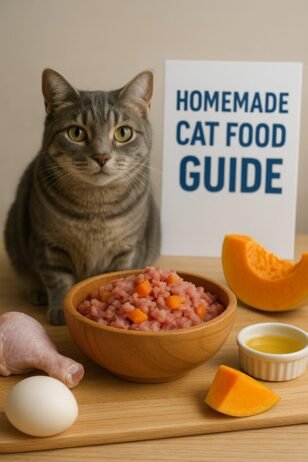Homemade Cat Food Guide
- 24 September 2025
- BuyAPet Editorial Team
- All Cats, Cat Health, Cats and Dogs
Homemade Cat Food Guide
Thinking about cooking for your cat? Here’s a UK-friendly, vet-smart guide covering safe ingredients, portion sizes, simple recipes, and when supplements matter.
Is homemade cat food safe?
Yes—if it’s complete and balanced. Cats are obligate carnivores with specific needs for taurine, arachidonic acid, vitamin A and D, and the right calcium-to-phosphorus ratio. Most “improvised” recipes miss at least one of these. If you want long-term homemade feeding, use a recipe formulated for cats and the correct supplements, or alternate with a complete commercial food.
Vet note: Kittens, pregnant/nursing queens, and cats with kidney, thyroid, or urinary issues need tailored recipes from your vet.
Feline nutrition basics (quick view)
What a complete meal includes
- Animal protein (muscle meat) as the base
- Organ meats (e.g., chicken liver) in small, controlled amounts
- Calcium source (e.g., bone meal or calcium carbonate)
- Essential amino acids (notably taurine)
- Omega-3s (fish body oil, not cod liver oil)
- Vitamins/minerals via a complete supplement
Things that often go wrong
- Too much liver → vitamin A toxicity
- No calcium → weak bones, fractures
- Seasonings (onion/garlic) → toxic
- Fish-only diets → thiamine deficiency
- Human multivitamins → unsafe levels for cats
UK ingredient quick list
Usually safe (plain, cooked)
- Chicken, turkey, beef, lamb (trim visible fat)
- Organs: liver (tiny amounts), heart, kidney
- White fish or salmon (boneless, occasional)
- Eggs (well-cooked)
- Small veg for fibre: courgette, pumpkin, peas (optional)
Never use
- Onion, garlic, chives, leeks
- Grapes/raisins, chocolate, alcohol
- Cooked bones (splinter risk)
- Excess salt, stock cubes, rich sauces
- Sweeteners like xylitol
Seasonings aren’t needed—cats prefer simple, lightly cooked meat with the right nutrients added.
Simple starter recipes (supplement required)
1) Chicken & Pumpkin Cat Bowl
Yield: ~4 portions for a 4 kg adult cat (adjust to your cat’s needs).
| Ingredient | Amount |
|---|---|
| Skinless chicken thigh, minced | 500 g |
| Chicken heart (optional, boosts taurine) | 60 g |
| Pumpkin or butternut squash, steamed & mashed | 60 g |
| Egg, well cooked | 1 medium |
| Fish oil (body oil, not liver oil) | 1–2 g |
| Calcium source (per product directions) | per label |
| Complete feline supplement (e.g., taurine, vitamins/minerals) | per label |
| Water | as needed |
Method
- Gently pan-cook chicken and heart until just done. Cool.
- Mix with pumpkin and chopped cooked egg. Add fish oil.
- Stir in calcium and full supplement dose per the brand’s instructions.
- Add warm water to a soft, moist texture. Portion and refrigerate.
2) Turkey & Rice Gentle Tummy Mix
Yield: ~3–4 portions.
- Turkey thigh mince 400 g
- Cooked white rice 60 g (optional; cats don’t need carbs, but a little can help texture)
- Chicken liver 20 g (do not exceed)
- Fish oil 1–2 g
- Calcium + complete feline supplement — per label
- Warm water as needed
Method: Cook turkey and liver thoroughly, mix with rice, add supplements and water, then portion.
Supplements: Use a UK-available complete cat supplement designed for home-prepared recipes. Follow the exact dosage per grams of meat.
Portions, transitions & storage
How much to feed?
- Adult cats: typically 35–45 kcal/kg body weight daily (guide only).
- Split into 2–3 meals; adjust for weight and activity.
- Always provide fresh water.
Storage
- Fridge: up to 48 hours in sealed tubs.
- Freezer: portion and freeze for up to 2–3 months.
- Reheat gently to room-warm (never hot).
Transition slowly over 5–7 days to avoid tummy upsets (mix with current food, increasing homemade gradually).
FAQs
Do I need supplements if I use organs and eggs?
Yes. Organs and eggs help, but they don’t reliably meet taurine, calcium, vitamin D, and trace mineral needs. Use a complete feline supplement and dose per the instructions.
Can kittens eat these recipes?
Kittens have higher energy and nutrient requirements. Only use kitten-specific, vet-formulated recipes or a complete commercial kitten food. Ask your vet for a growth plan.
Is raw feeding better?
Raw diets can carry bacteria and parasites. If you choose raw, use reputable UK suppliers that produce complete meals for cats, handle safely, and consult your vet.
What signs mean the diet isn’t right?
Look for dull coat, flaky skin, lethargy, weight loss/gain, diarrhoea/constipation, or picky eating. If you see these, revert to a complete food and speak to your vet.
Can I skip carbs entirely?
Yes—cats don’t require carbohydrates. Small amounts of pumpkin, squash, or rice can help texture or digestion but are optional.
This article is for general information and does not replace personalised veterinary advice.
